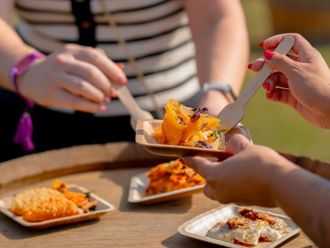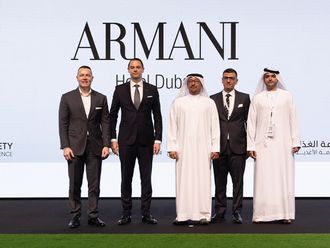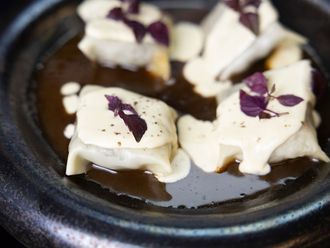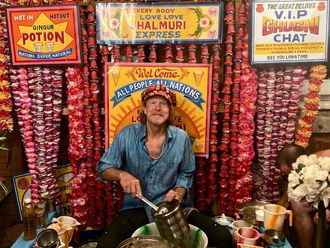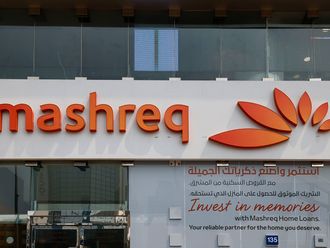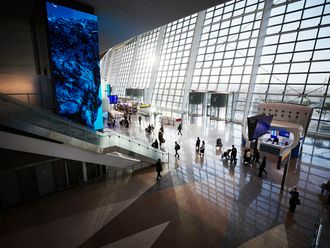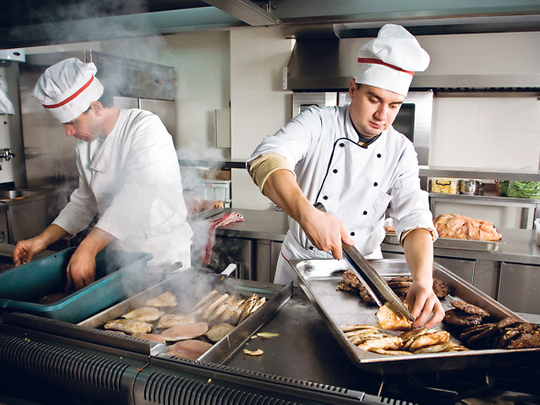
Before your perfectly cooked steak appears on your table at your favourite restaurant, it will have been through a maze of storage, preparation and cooking areas in a large, busy industrial kitchen unrecognisable from your kitchen at home.
Legal requirements, type of cuisine and number of guests can all have an impact on what is included in the workspace. But what makes a good restaurant kitchen, and do chefs have any preference for — or even influence on — what goes into their workplace?
Alan Pedge, Executive Chef at Samaya Hotel, Deira
According to chef Pedge, once you have been working as a chef for a while you begin to realise the design and layout of your working environment can either make your job easier or harder. "One of the drawbacks of professional kitchens is that until recently, chefs were not involved in designing the kitchen," he says.
"Kitchen design is very specialised and now, companies are realising you need at a corporate level someone involved in kitchens professionally. The layout, design and equipment all affect the end product."
Chef Pedge says the kitchen must be designed according to a logical workflow; "Receiving, washing, storing, preparation, cooking and serving." Trying to establish a logical workflow in a kitchen designed and built without this in mind, he says, is difficult.
Quality appliances are also paramount for chef Pedge. "It's better to spend that little bit more, as the better your appliances the better you can do the job," he says. "It gives you far more versatility."
And appliances should also reflect the cuisine prepared in the kitchen, he says — having the right equipment and planning for what you produce is essential.
"You can't cook Arabian cuisine in a kitchen designed for Chinese food," says chef Pedge. "The right equipment means the chef can do the right job."
With food hygiene a priority, chef Pedge prefers his surfaces made of a non-porous material. "Stainless steel is far better for an industrial kitchen," he says. "No wood should be allowed, and glass is dangerous. Plastic or stainless steel is better."
Alex Montano Executive Chef and General Manager at Maria Bonito's Taco Shop, Jumeirah
A restaurant catering for upwards of 250 customers daily, all looking for authentic Mexican cuisine, keeps chef Montano and his staff busy.
To ensure authenticity, the majority of the restaurant's kitchen — including equipment, fittings and ingredients — is imported from Mexico. "We bring in ingredients for the menu, specialised equipment and — most importantly — our tortilla machines," says chef Montano.
Tortilla machines are the most important feature in any Mexican kitchen, with so many traditional dishes reliant on the corn or flour pancake, according to chef Montano. "Our machines make 500 to 600 tortillas per hour, so maybe 4,000 in one day," he says. "Our jobs would be very difficult indeed without the tortilla machines."
While chef Montano says space is important, as long as the kitchen staff know what they are doing the kitchen can operate efficiently even if space is at a premium. "All our staff have specific responsibilities so they know what they have to do and where," he says. "That way nobody bumps into each other even if we don't have much space. Besides, it's more important that we have the right equipment rather than lots of space."
The kitchen at Maria Bonito's is open-plan, so restaurant patrons can see the chefs busy at work.
"I think open plan kitchens are better than those hidden away, as customers like to see what goes on in the kitchen as you're preparing their meal," says chef Montano.
While chef Montano would be perfectly capable of whipping up an authentic Mexican meal in a kitchen designed for another cuisine, he says it is always better to be in a kitchen geared towards the food you are cooking. "Of course if we had to, we could make Mexican food in a Japanese restaurant, but we are happier in our own kitchen with our tortilla machines," he says.
Thorsten BeermannExecutive Chef at Media Rotana, Al Barsha
Adequate storage would be top of chef Beermann's wish list for his ideal kitchen. "This is where you start," he says. "Then I'd need a large worktop for preparing, enough space for cooking, space for finishing off, and a large centre table. The kitchen would need to be in sections, split down into several areas in which staff can work."
The so-called work triangle in the kitchen, including the sink, the cooker and the refrigerator, is a sensible approach according to chef Beermann. "It makes sense for the workflow."
While chef Beermann's kitchen normally has about 40 people working in it, organisation is not a problem. "It's a big space and everyone knows their tasks," he says.
"A working kitchen needs to be designed in a way that makes sense, though, so each person is able to do their work, and the most important thing is for the food finishing to be at the end of the line, so you don't hamper yourself."
Chef Beermann feels most cuisines can be prepared in the same type of kitchen, without special adjustments being required. "Most types of food go through the same procedure," he says.
Health and safety measures
Industrial kitchens such as those in hotels and restaurants must not only consider strategically positioned equipment and the latest technology. Health and safety regulations must also be strictly applied, accordingto the chefs.
Alan Pedge, Executive Chef at Samaya Hotel in Deira, says a system for ensuring regulations are met is required in industrial kitchens, for each stage involving food. The Hazard Analysis and Critical Control Points system (HACCPs), established in the United States in the 1960s,identifies hazards involved with the transportation, storage, preparation and cooking of foods in order to minimise risks at each stage.
"You need separate washing facilities," he says. "You wouldn't wash anything food-related in the same sink as pots and pans or your hands, as all industrial kitchens have to follow the principles of the HACCPsystem and equipment must be placed accordingly."
Thorsten Beermann, Executive Chef at Media Rotana in Al Barsha, agrees. "There must be separate cleaning facilities for hands, away from food washing areas, and both must be easily accessible," he says.
Such regulations have meant changes in industrial kitchens, says chef Alan. "Kitchens used to need only two sinks, whereas now due to new rules for sanitising, we need three. We also need more storage now, as we need separate storage areas — for example, for red meat and for poultry."




